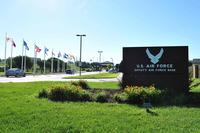ORLANDO -- Tightening budgets during a time that will see increased demand for Air Force capabilities means that the service and defense industry must work together with 'ruthless discipline' to ensure deliveries of high priority weapons like the F-35 Join Strike Fighter and the KC-46A tanker, said Air Force Chief of Staff Gen. Norton Schwartz Thursday.
"As we make key decisions through low-rate initial production lots of F-35 and KC-46, our top acquisition priorities, we cannot afford any splintering of our unity and in effect, undermining our shared effort to deliver the centerpieces of future tactical air combat and strategic airlift capabilities as part of an appropriately balanced force structure," said Schwartz during a speech at an Air Force Association-sponsored conference here.
"Now more than ever, on any number of wide-ranging issues, this is the time for harmonized voices and close partnerships. We may not agree with complete unanimity on how to compose a smaller force in every single detail but we can all agree that we must avoid a lesser force."
He went on to warn industry to work with government to "relentlessly keep costs down" with affordability designed into new weapons buys and built into contracts. He also admitted that the air service must stabilize requirements by matching "ambition with actual operational needs."
Still, industry must deliver capabilities on cost and on time, Schwartz warned.
"Responsible stewardship of precious taxpayer dollars demands that we avoid procuring unnecessary for the government or dispensing handsome financial bonuses to industry for unmet milestones and cost creep," he added what may have been a thinly veiled reference to the F-35 which has continued to suffer from production delays and cost growth.
All of this comes at a time when the Pentagon is in the midst of a budget cut that will see the Air Force retiring 286 fighter, UAVs and cargo haulers in the coming years -- a move expected to save the service $8.7 billion. This is being done to free up cash for investment in next generation weapons like the JSF, KC-46 tanker, a new long-range bomber, UAVs and satellites.
All of these new weapons are needed to counter 21st Century threats with an Air Force that is the smallest it has ever been, said Schwartz.
"We face a readiness conundrum, the Air Force will get smaller due to reduced budgets but we will also become more valued due to the current and anticipated security environment as described by the new defense strategic guidance," said Schwartz. "This strategy emphasizes Air Force capabilities as fundamental to its major priorities such as deterring and defeating aggression, projecting power in anti-access and area denial environments, preventing the spread of [WMD] conducting space and cyber operations and maintaining the preponderance of the nation's nuclear deterrent."
This smaller Air Force will also work even closer with the Navy as the Pentagon shifts its focus from land toward air and sea warfare, he added.
"A broader strategic partnership between the air and sea services, as articulated in the air-sea battle concept, will be ever more important to ensure our access to the global commons and freedom of action wherever we have national interests," said the general.
The service must work with all the other military services to come up with "highly integrated and tightly coordinated operations" to defeat future enemies, he added.









